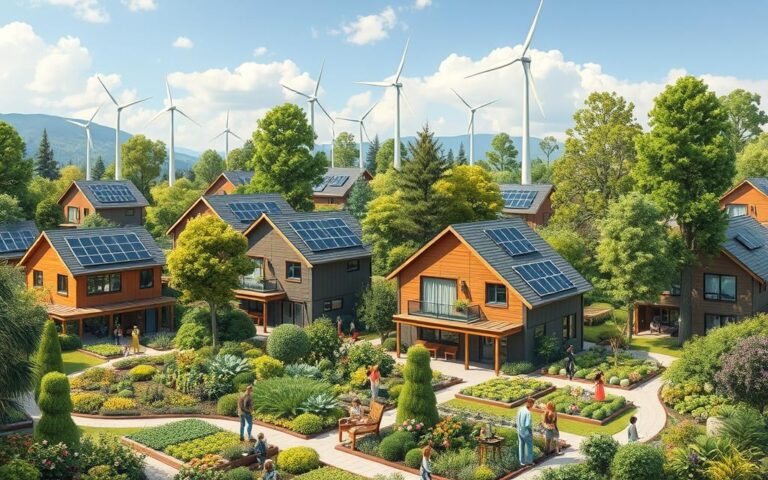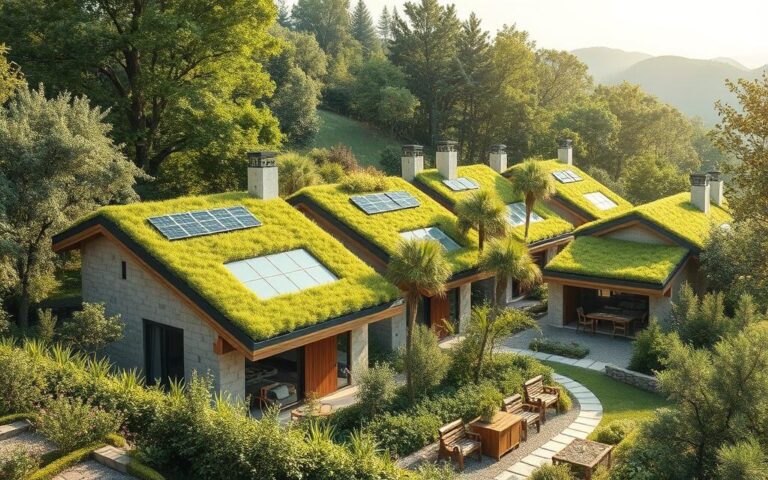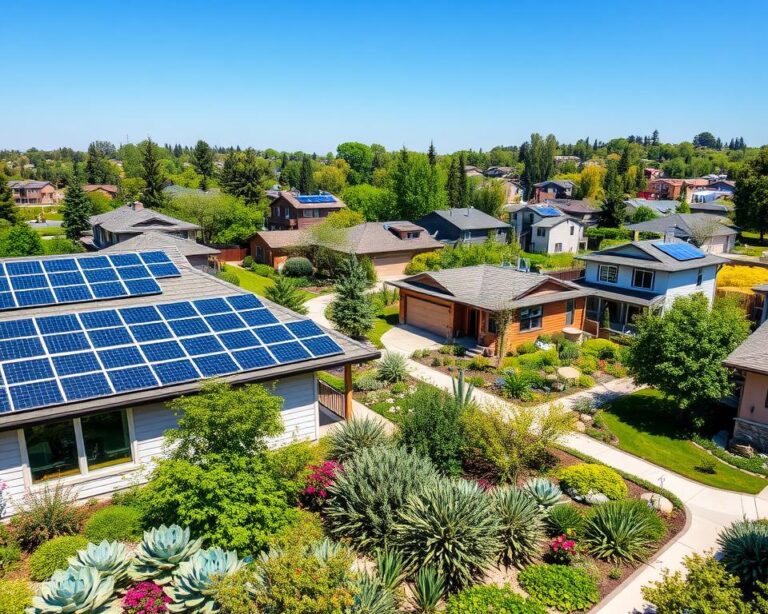Did you know bamboo can grow up to 1.5 inches per day? This shows how fast it grows, making it a top choice for green building. The building industry is big, with about 40% of global carbon emissions coming from it. To cut down on emissions, builders are using materials that are better for the planet.
This article will explore the top ten eco-friendly materials for building. We’ll see how their use changes based on where they’re found, local customs, and the weather. We’ll look at how materials like recycled steel and straw bales can help make buildings more sustainable.

Understanding Eco-Friendly Materials in Construction
Eco-friendly materials are key in building that’s good for the planet. They’re not just recyclables. They also reduce harm to the environment and make buildings better for people inside. How these materials are made and used is important for their eco-friendliness.
What Makes a Material Eco-Friendly?
To be eco-friendly, materials must meet certain standards. These include:
- Renewable sourcing, ensuring materials can be replenished without depleting the earth’s resources.
- Low environmental impact, which reduces harm during manufacturing and usage.
- Durability and lifespan, doing away with frequent replacements and waste.
- Improved indoor air quality, minimizing the emission of harmful chemicals.
Benefits of Using Eco-Friendly Materials
Using sustainable materials has many benefits. Some of these are:
- Cost-Effectiveness: Recycled materials like reclaimed wood and steel can be cheaper than new materials, leading to significant savings in construction projects.
- Energy Efficiency: Sustainable materials such as recycled wood offer superior insulation properties, which can lower energy consumption in buildings.
- Design Flexibility: Eco-friendly materials allow architects and designers to create unique aesthetics through various textures and colors.
- Healthier Indoor Environments: Natural materials like cork and bamboo flooring emit fewer harmful chemicals compared to traditional options, enhancing indoor air quality.
Common Misconceptions
Even though eco-friendly materials are becoming more popular, some myths still exist. Some think they’re too expensive or don’t perform well. But, using these materials can actually save money and meet high standards. The construction world is embracing them for their many benefits and help in achieving sustainability goals.
Bamboo: The Renewable Wonder
Bamboo is a top pick for eco-friendly building materials. It grows fast and is strong for its weight. This makes it perfect for green construction projects. Let’s look at why bamboo is great and how it’s used in building.
Why Choose Bamboo?
Bamboo grows in 3 to 5 years, beating traditional hardwoods. Its quick growth means it can be harvested often. This keeps a steady supply of eco-friendly material.
Also, bamboo pulls a lot of carbon dioxide from the air. It does this as well as many trees. This helps buildings be kinder to the planet.
Sustainable Harvesting Practices
Harvesting bamboo is done in a way that’s good for the environment. Bamboo’s wide roots help keep the soil stable. This stops erosion and keeps the ecosystem balanced.
By choosing bamboo, we support sustainable practices. This helps us build in a way that’s better for our planet.
Recycled Steel: Strong and Sustainable
Recycled steel is becoming a top choice for green building. It’s strong and can be recycled forever without losing quality. This makes it great for those who care about the environment.
Environmental Advantages
Using recycled steel is good for the planet. It takes a lot less energy to make than new steel, which means less pollution. For example, recycling one car saves as much energy as burning 150 gallons of gasoline.
Recycling a fridge also cuts down on CO2 emissions by 215 pounds. This shows how important recycled steel is for a greener construction industry.
Life Cycle of Recycled Steel
The journey of recycled steel starts with collecting scrap. In North America, we recycle 60 to 80 million tons of steel every year. Over the last 30 years, we’ve recycled over one billion tons.
This steel is reused in many ways, like in building frames and roofs. Recycling one ton of steel saves a lot of resources. It saves 2,500 pounds of iron ore, 1,400 pounds of coal, and 120 pounds of limestone.
How It’s Used in Construction
Recycled steel is used in many ways in building. It lasts longer and needs less upkeep, saving money in the long run. This is good for developers and builders.
The steel industry also helps recycle 12 million appliances every year. They’ve even made stronger recycled steel beams. This meets green building standards, helping builders get points for sustainability.
Rammed Earth: Natural and Durable
Rammed earth construction combines old techniques with new eco-friendly methods. It uses natural materials found on site, making it green. This method also keeps buildings cool or warm, thanks to its thermal mass.
Properties of Rammed Earth
Rammed earth is popular for its strength and eco-friendliness. It can bear loads like traditional brick walls. Its clay and porous nature also control humidity, making homes comfortable.
Building Techniques
Building with rammed earth is mostly done by hand. This method is cost-effective and supports sustainable building. It’s important to keep walls dry during and after building to keep them strong. Australia and New Zealand have rules to ensure safe use of this technique.
Cost-Effectiveness
Using local materials makes rammed earth structures energy-efficient. Only a small amount of cement is needed, about 6 to 8%. This makes rammed earth a budget-friendly choice for green building.
| Feature | Rammed Earth | Brick Masonry |
|---|---|---|
| Compressive Strength | 42 kg/m² | Comparable |
| Embodied Energy | Low (locally sourced) | Higher (dependent on manufacturing) |
| Cement Content | 6-8% | Varies (higher percentage) |
| Construction Method | Manual, labor-efficient | Typically machine-assisted |
| Humidity Control | Effective due to clay content | Limited |
Straw Bale: Insulation with a Twist
Straw bale construction is a standout in sustainable building, known for its top-notch insulation. It uses straw bales, blending environmental benefits with beauty. This natural material boosts energy efficiency and supports eco-friendly insulation.
Benefits of Straw Bale Construction
Straw bale homes offer big wins for people and the planet. Here are some key benefits:
- Can save about 75% on heating and cooling costs.
- It’s cost-effective, with initial costs similar to regular homes but lower costs over time.
- It reduces wood use, helping forests.
- It’s three times more fire-resistant than traditional houses.
- It cuts down on greenhouse gas emissions, as building accounts for about 30% of U.S. emissions.
Climate Considerations
Weather affects how well straw bale homes insulate. Straw bales naturally control temperature and humidity, fitting many climates. In hot areas, they keep it cool; in cold areas, they keep it warm. They also handle moisture well, lasting long in different weather.
Aesthetic Options
Straw bale homes also offer great looks. Their rustic charm and textures can be enhanced with plaster or clay. Owners can choose from many designs that are both eco-friendly and creative.
Using straw bale in building is a step towards a greener future. It’s efficient, safe, and has a unique look, fitting today’s eco-friendly building trends.
| Feature | Straw Bale Homes | Conventional Homes |
|---|---|---|
| Heating/Cooling Cost Savings | ~75% | Higher |
| Fire Resistance | 3x higher | Lower |
| Environmental Impact | Minimal wood consumption | Higher wood consumption |
| Greenhouse Gas Emissions | Lower | Higher |
Straw bale construction is a smart move towards a greener future. It combines practicality with beauty.
Reclaimed Wood: A Second Life
Reclaimed wood is a great choice for building sustainably. It comes from old buildings, bridges, and more. Using it means we don’t have to cut down as many trees, helping forests and animals.
Sourcing Reclaimed Wood
There are several ways to get reclaimed wood:
- Post-consumer reclaimed wood comes from old buildings, bridges, and bleachers.
- Post-industrial reclaimed wood is from furniture waste, avoiding landfills.
- Water reclaimed tropical wood is from flooded areas, harming no trees.
- Orchard salvage saves trees from landfills in orchards.
- Forest floor salvage gets smaller trees left after logging.
Design Versatility
Reclaimed wood is versatile, used in floors, furniture, and more. It brings warmth and a unique story to spaces. It makes places inviting, boosting well-being and mood.
Its popularity shows a growing love for green building. It attracts those who care about the planet.
Environmental Impact
Choosing reclaimed wood helps the environment a lot. It cuts down on landfill waste and saves forests. It also needs less energy to use, making it better for the planet.
Plus, it’s durable, thanks to coming from old-growth trees. This means buildings last longer, saving resources.

Recycled Plastic: Innovative Solutions
Recycled plastic is becoming a big deal in eco-friendly building materials. The construction world is now using recycled plastics to cut down on waste. This change helps the environment and makes building materials last longer and be more versatile.
Types of Recycled Plastics Used
There are many kinds of recycled plastics used in building, including:
- Recycled Polyethylene Terephthalate (rPET): Commonly used for bottles and packaging.
- High-Density Polyethylene (HDPE): Ideal for durable products like piping and plastic lumber.
- Low-Density Polyethylene (LDPE): Often used in various construction applications, providing flexibility.
- Polypropylene (PP): Popular for its impact resistance and used in living materials.
Durability and Maintenance
Recycled plastics are very durable. They can withstand weather, rot, and mold, making them great for different places. They also need little upkeep; just a quick clean and they’re good as new, unlike regular materials.
Real-World Applications
Many projects show how recycled plastic works well in building, including:
- Minus Degre: Offers a range of products, including Eco-Panels, furniture, and artistic pieces made from 100% recycled plastic.
- Eco-Friendly Gift Hampers: Shows how recycled plastic can be used in everyday items.
- Recycled Tiles: These tiles are a green choice for walls and floors, liked by both home and business builders.
Using recycled plastic in building helps reduce waste and cuts down on carbon emissions. As the building world gets greener, recycled plastic is a top choice. It’s both useful and good for the planet.
Concrete Alternatives: Eco-Friendly Options
The construction world is looking for green concrete options. These alternatives aim to cut down on environmental harm without losing performance. Traditional concrete makes up about 8% of global CO2 emissions. Looking into sustainable materials is key for a greener tomorrow.
Hempcrete: A Bio-Based Solution
Hempcrete is a standout eco-friendly concrete choice. It’s made from hemp hurds and lime, needing less water than regular concrete. It also keeps buildings cooler, thanks to its thermal properties.
Hempcrete is light, which cuts down on energy needed for transport and making it. It also absorbs CO2, helping the planet. Its ability to insulate and capture carbon makes it a top choice for green building.
Perlite and Pumice: Lightweight Fillers
Perlite and pumice are great for making concrete lighter. They cut down the energy needed to make concrete. They also help keep buildings warm in winter and cool in summer.
By adding perlite and pumice to concrete, builders can make buildings more eco-friendly. These materials help create strong, lasting spaces with less environmental harm.
Benefits of Alternative Concrete Mixes
- Sustainability: Eco-friendly concrete cuts down on carbon emissions and uses less traditional materials.
- Durability: Some alternatives, like Ferrock, are stronger and can even absorb CO2.
- Resource Efficiency: Self-healing concrete can last longer, needing fewer repairs and using less resources.
Switching to alternatives like hempcrete, perlite, and pumice is good for the planet. It also meets the need for strong, efficient buildings. As the industry grows, green concrete is becoming a key part of building sustainably.
Natural Stone: A Timeless Choice
Natural stone is a top pick for building materials because it’s so durable and looks great. It’s been used for centuries, from old buildings to new ones. This makes it a favorite among architects and builders.
Types of Natural Stone
There are many types of natural stone used in building, each with its own look and feel:
- Granite: It’s tough and comes in many colors, perfect for countertops and floors.
- Marble: Known for its beauty and patterns, marble is often used in fancy places.
- Sandstone: It’s good for both inside and outside, adding a rustic feel to buildings.
- Slate: Slate is strong and easy to care for, often used for roofs and floors.
- Quartzite: It has unique streaks and colors, making it a favorite for its beauty and strength.
Advantages of Using Natural Stone
Using natural stone has many benefits for eco-friendly building:
- It’s very durable, so buildings made of it last longer and need less fixing.
- It needs less energy to get and process than concrete or fake materials.
- It can be reused, saving energy and resources.
- It’s safe and doesn’t cause allergies, making indoor air better.
- It comes in many colors and textures, offering endless design options.
Sustainability Considerations
There are ways to make quarrying natural stone even greener:
- Working to fix quarry sites helps reduce harm to the environment.
- It has lower carbon emissions than making fake materials.
- It helps keep temperatures steady, making outdoor spaces more comfortable.
- It needs little upkeep, saving on harmful chemicals and resources.
Insulation Materials: Eco-Friendly Choices
Insulation materials are key to making buildings more energy-efficient. Eco-friendly insulation helps save energy and improves indoor air quality. It’s important to look into different eco-friendly insulation types for sustainable construction.
Types of Eco-Friendly Insulation
- Aerogel: Known as the “superman” of insulation, it boasts an impressive R-value of 10.3 per inch while being composed of 90% air.
- Icynene Spray Foam: Derived from castor oil, this insulation expands to fill gaps, providing R-values of 3.6 per inch and reducing energy bills by 30-50% annually.
- Cellulose: Composed of 75-85% recycled materials, cellulose offers a sustainable option while competing in price with traditional insulations.
- Sheep’s Wool: With natural moisture-regulating properties, this insulation contains up to 20% polyester for added durability and showcases a great R-value.
- Cork: A natural insulator, cork absorbs carbon dioxide even after installation, contributing to its eco-friendly credentials.
Benefits Beyond Sustainability
Choosing eco-friendly insulation offers more than just sustainability. It can cut down on heat loss by up to 60%. This makes homes more comfortable and improves air quality, creating a healthier living space.
Cost Implications
Initial costs for eco-friendly insulation can be higher than traditional materials. For example, sheep’s wool insulation costs between £18 to £25 per square meter. But, it can save money over time with lower energy bills and longer lifespan.
Buildings in colder climates benefit from higher R-values, making eco-friendly insulation a smart investment. It’s a cost-effective choice for the long term.
Getting Started with Eco-Friendly Construction
Starting eco-friendly construction needs careful planning. Look into sustainable building practices from the start. Choose materials that last long and can be recycled, like recycled steel or cork.
These materials make buildings strong and help save resources.
Tips for Integrating Eco-Friendly Materials
Start by buying materials locally. This helps your community and cuts down on emissions. Using recycled steel or bamboo makes your project efficient and strong.
Finding Local Suppliers
It’s key to find local suppliers for eco-friendly materials. Look for vendors with sustainable products like reclaimed wood or recycled glass. Supporting local businesses helps the environment and the economy.
Funding and Incentives for Green Building
Looking into green building incentives is important. Many programs offer funding to help with costs. Governments give grants, tax credits, and rebates for energy-efficient projects.
These incentives make it easier to use eco-friendly materials and practices.
FAQ
What defines eco-friendly materials in construction?
Eco-friendly materials in construction have a low impact on the environment. They are sustainably sourced and energy-efficient. They also help reduce greenhouse gas emissions throughout their life cycle.
What are the key benefits of using sustainable materials?
Sustainable materials reduce environmental impact and improve energy efficiency. They also enhance indoor air quality and can save money on energy bills. Plus, they improve the health and well-being of those who live in the buildings.
Are eco-friendly materials more expensive than traditional materials?
Some eco-friendly materials might cost more upfront. But, they can save money in the long run by reducing energy bills and maintenance costs. Their benefits often make them a smart choice over time.
How is bamboo considered an eco-friendly building material?
Bamboo is eco-friendly because it grows quickly and can be harvested sustainably. It’s also strong and light, making it great for flooring and framing.
What are the environmental advantages of recycled steel?
Recycled steel is good for the environment because it can be made over and over without losing quality. It also uses less energy to make than traditional steel.
What is rammed earth, and why is it sustainable?
Rammed earth uses local soil and aggregates to build strong structures. It’s energy-efficient because it helps keep temperatures stable inside. This makes it a green alternative to other building materials.
How do straw bale houses offer insulation benefits?
Straw bale houses are well-insulated because straw is a natural insulator. This makes them comfortable in different climates and cuts down on energy use for heating and cooling.
What are the advantages of using reclaimed wood?
Reclaimed wood saves forests by reducing the need for new timber. It also keeps waste out of landfills and adds unique beauty to designs. Plus, it helps biodiversity by reducing logging.
What types of recycled plastics are utilized in construction?
Recycled plastics in construction come from bottles and containers. They can be turned into bricks, lumber, and roofing materials. These products are durable and help with sustainable building.
What are eco-friendly alternatives to traditional concrete?
Eco-friendly alternatives include hempcrete for insulation and carbon sequestration. Perlite and pumice are used as lightweight fillers. These options use less energy and are more sustainable.
How does natural stone contribute to sustainable construction?
Natural stone is durable and beautiful, making it a sustainable choice. When used responsibly, it lasts long and reduces waste and resource use.
What are some eco-friendly insulation materials?
Eco-friendly insulation materials are cellulose, sheep’s wool, and cotton batts. They improve energy efficiency and indoor air quality, making buildings more comfortable.
How can builders begin using eco-friendly materials in their projects?
Builders can start by researching local suppliers and choosing sustainable materials. They can also look for funding and government incentives for green building. Using local resources and engaging with the community is also key.




